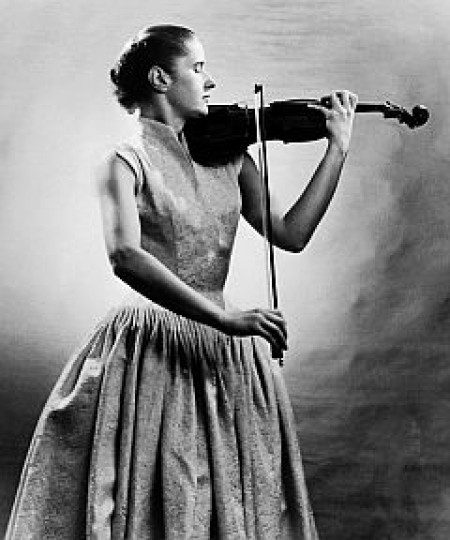
26 October 1924, Temesvár – 13 August 1979, Rüschlikon
Johanna Martzy began learning the violin at the age of six; by thirteen she appeared at a public concert in Budapest. It is difficult to give a precise picture of her studies in the Hungarian capital. Most sources give 1932-1942 as the period when she studied at the Music Academy; elsewhere, however, it is stated that "she was already Jenő Hubay's pupil when at the age of ten she started attending the Music Academy". The name of Johanna Martzy appears on the list of Music Academy students only for the academic year 1938/39 – though already as a third year student – as Ferenc Gábriel's pupil. The legend, probably not without foundation, according to which Hubay, hearing the eight-year-old child prodigy play, predicted a future for her as one of the best violinists in the world, seems to validate the date of 1932 as the year when they met (and when her studies with him began), even if these were not within the official framework of the Academy. Later the direction of her studies was taken over by Gábriel, who had also been Hubay's pupil.
The successes of the "official" Music Academy years validated Hubay's prediction. In the 1939/40 academic year Martzy won one of the hundred pengő rewards of the Jenő Hubay Society, as well as the Reményi Prize (a Reményi master violin), and in the 1941-42 academic year, together with the artist diploma issued by the state, the capital's 200 pengő Jenő Hubay grant – i.e. the "real" Hubay Prize. By 1943 she appeared with the Budapest Philharmonic Society Orchestra under Willem Mengelberg.
In 1947 - as the first and to this day only female winner – she won first prize at the Geneva international competition, after which she went on a highly successful European tour. She left Hungary permanently in 1948, settling in Glarus in Switzerland. Thereafter the Hungarian audience could hear only news of her world success. Her much applauded debut in Great Britain in 1953 led to a whole series of tours in the next decade or so. Her first appearances in America in 1957 similarly generated a flood of new invitations; she also appeared in the most important concert venues in Africa and Australia. She regularly appeared with the best orchestras and conductors, such as Georg Solti, Eugene Ormándy, Otto Klemperer, Igor Markevitch, Paul Kletzky and Ernest Ansermet. Besides this, she also gained a name as a chamber musician, particularly at the time of her cooperation with the excellent Dutch pianist,
Jean Antonietti. She came to Budapest in November, 1969, with her new post-1966 permanent partner, István Hajdú, but after that, in the seventies, she accepted fewer and fewer invitations to perform. By the time of her death on 13 August 1979, at the age of only fifty-five, she had been living for a long time in complete retirement in her home in Glarus.
Fortunately, there are many recordings of her performances. The critics regard as her most outstanding performances the 1954/55 recording of Bach solo sonatas and partitas, particularly the D minor chaconne, but the Dvorák concert recorded with the participation of Ferenc Fricsay and the RIAS Symphony Orchestra also counted over the decades as the authoritative recording of that work. Martzy carried on the best traditions of the Hungarian school of violin playing. In the evaluations of foreign experts we can read everywhere of her "passionate tone", "her forward-driving rhythm", and the "brilliant flexibility of her technique". In her hands, Bronislaw Huberman's (according to other sources Jenő Hubay's) Stradivari found a worthy master.
B. M.


